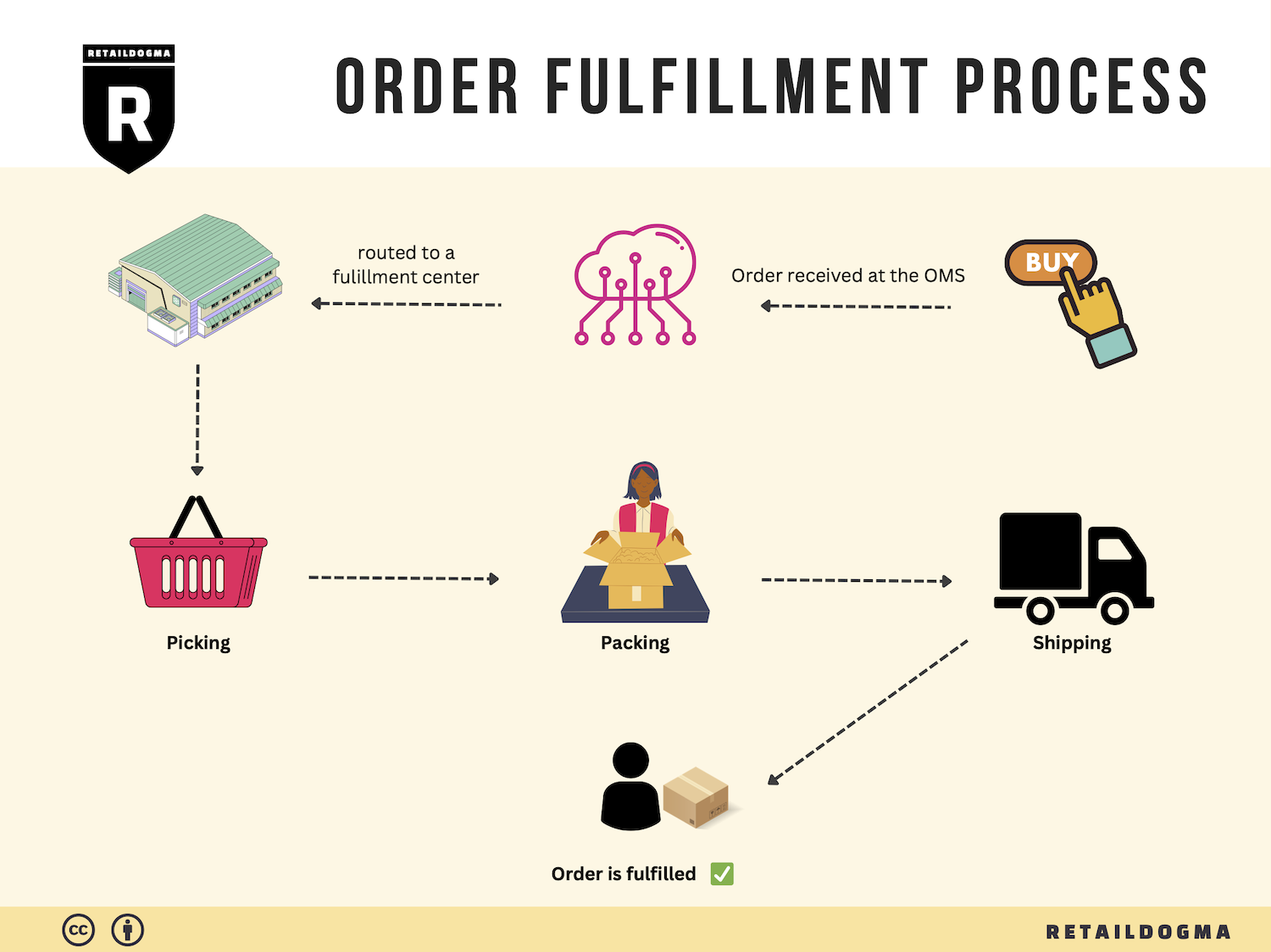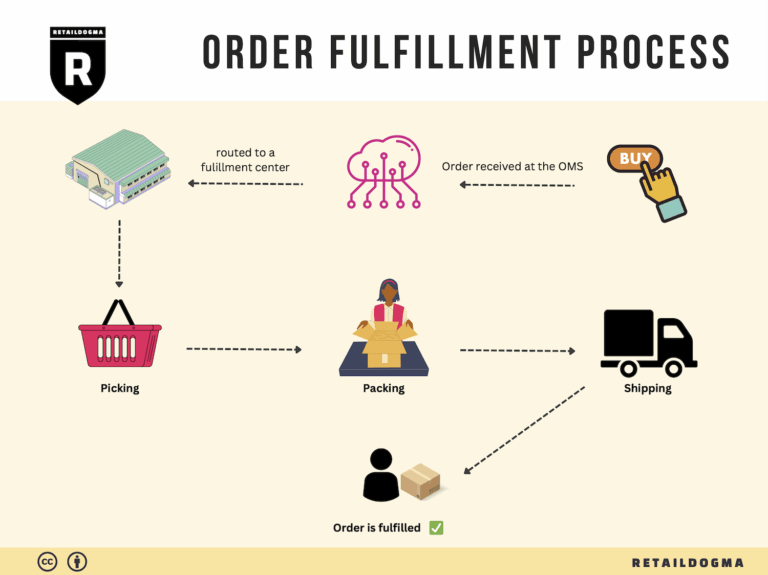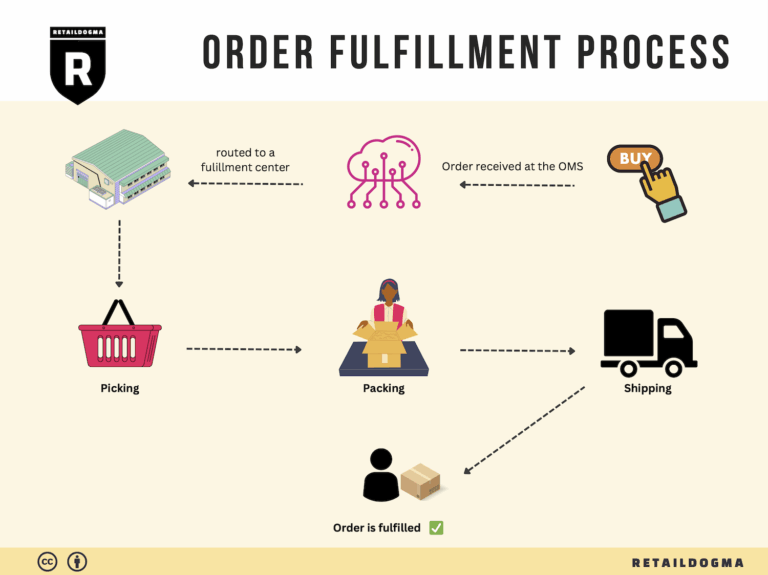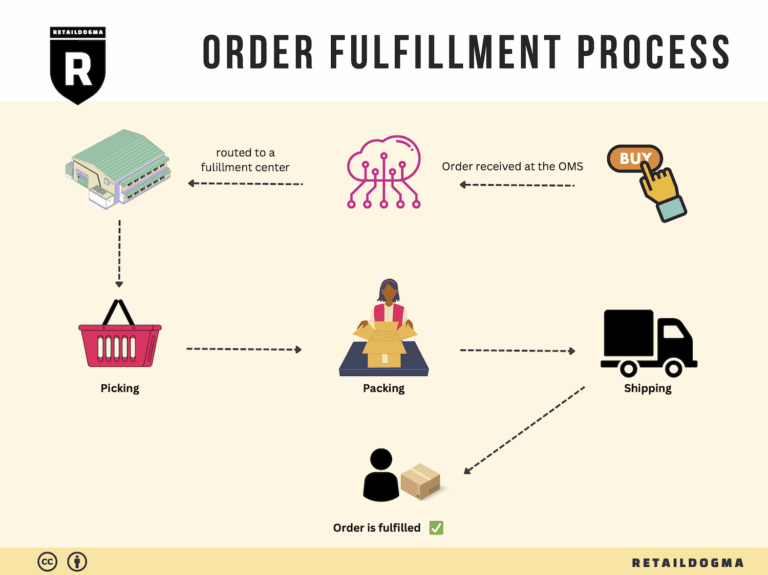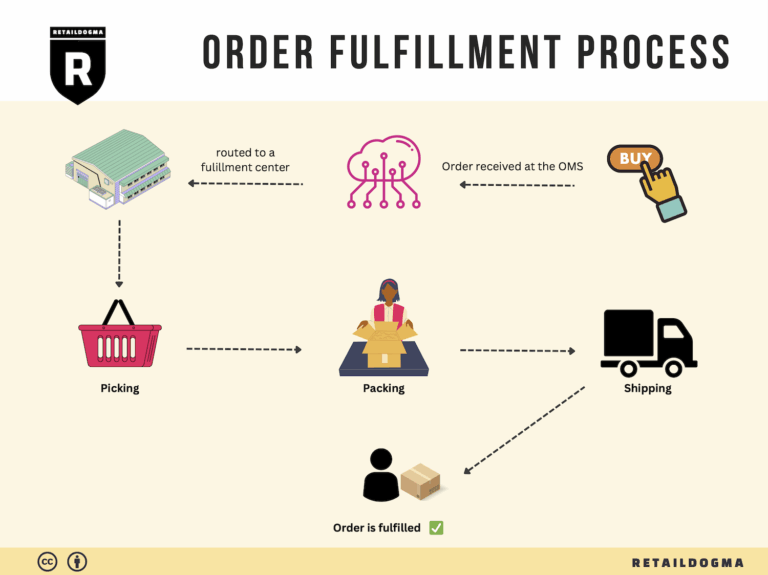How Order Fulfillment Works: A Step-by-Step Guide for Businesses
What is E-commerce Fulfillment? An Introduction for Growing Businesses
Understanding E-commerce Fulfillment
As your e-commerce business begins to thrive, you may find yourself grappling with the complexities of packing and shipping orders. This common pain point can quickly become overwhelming, detracting from the time and energy you need to scale your sales and refine your product offerings. Fulfillment, in its simplest form, is the process of getting a product to a customer—an essential operation that can make or break your business’s reputation and growth potential.
This guide aims to demystify e-commerce fulfillment, particularly in the cosmetics sector, where product integrity and customer experience are paramount. We will delve into various fulfillment models, including third-party logistics (3PL) and Fulfillment by Amazon (FBA), each offering unique advantages tailored to different business needs. Understanding these models will help you determine which aligns best with your operational goals and customer expectations.
Core services play a pivotal role in the fulfillment process. From inventory management and order processing to packing, shipping, and returns handling, each step must be executed with precision. We’ll explore these services in detail, emphasizing how they contribute to an efficient and customer-centric fulfillment strategy.
Choosing the right fulfillment partner is critical for your business’s success. With an array of providers available, it can be daunting to navigate the options. This guide will provide practical tips on evaluating potential partners, focusing on factors such as their experience in the cosmetics industry, technology capabilities, and customer service standards.
Pricing is another crucial aspect we’ll address. Understanding the cost structures of different fulfillment services will empower you to make informed decisions that align with your budget and growth ambitions. We will break down common pricing models and highlight what to watch for in terms of hidden costs or additional fees.
Ultimately, the goal of this guide is to empower you with the knowledge needed to make smart, strategic decisions about your logistics operations. By understanding the nuances of e-commerce fulfillment, you can enhance your customer experience, streamline your operations, and set the stage for sustainable growth in your cosmetics business.

What You’ll Learn In This Guide
- What is E-commerce Fulfillment? An Introduction for Growing Businesses
- The Order Fulfillment Process: From ‘Buy’ Button to Customer’s Door
- Comparing Fulfillment Models: In-House vs. 3PL vs. Dropshipping
- A Deep Dive into Amazon FBA: Pros, Cons, and Who It’s For
- Core Services Offered by Fulfillment Centers
- How to Choose a Fulfillment Partner: A 6-Point Checklist
- Understanding Fulfillment Pricing: A Breakdown of Common Fees
- Frequently Asked Questions (FAQs) about Fulfillment
- Conclusion: Is Outsourcing Fulfillment the Right Move for Your Business?
- Important Disclaimer
The Order Fulfillment Process: From ‘Buy’ Button to Customer’s Door
1. Receiving Inventory
The order fulfillment process begins with receiving inventory. When products arrive at your fulfillment center, they undergo a thorough inspection to verify that the correct items and quantities have been delivered. This step is crucial for maintaining accurate stock levels and ensuring product quality. Any discrepancies, such as damaged goods or incorrect shipments, should be addressed immediately to prevent future issues.
During the receiving process, key terms like SKU (Stock Keeping Unit) come into play. SKUs are unique identifiers assigned to each product, enabling easy tracking and management of inventory. Properly documenting and labeling SKUs at this stage helps streamline future operations, ensuring that products are easily located and accounted for. Establishing a systematic receiving process not only protects your investment but also sets a solid foundation for efficient order fulfillment.
2. Warehouse Storage
Once the inventory has been received and verified, it is stored in the warehouse. Effective warehouse management is vital to optimizing space and ensuring that products are accessible when needed. Different storage systems can be employed based on product type, such as climate-controlled areas for sensitive cosmetics or shelving for smaller items.
Utilizing ABC analysis—a method of categorizing inventory based on importance and turnover rates—can help determine the best storage locations for products. High-demand items should be stored closer to the packing area, while less frequently ordered products can be placed further away. A well-organized storage system minimizes retrieval times, reduces labor costs, and enhances overall efficiency, directly impacting customer satisfaction.
3. Order Picking
As orders are placed, the next step is order picking, where items are selected from storage to fulfill customer requests. This stage is critical because the accuracy and speed of picking directly affect delivery timelines and customer satisfaction. A common tool used in this process is a pick list, which details the items, quantities, and their respective locations within the warehouse.
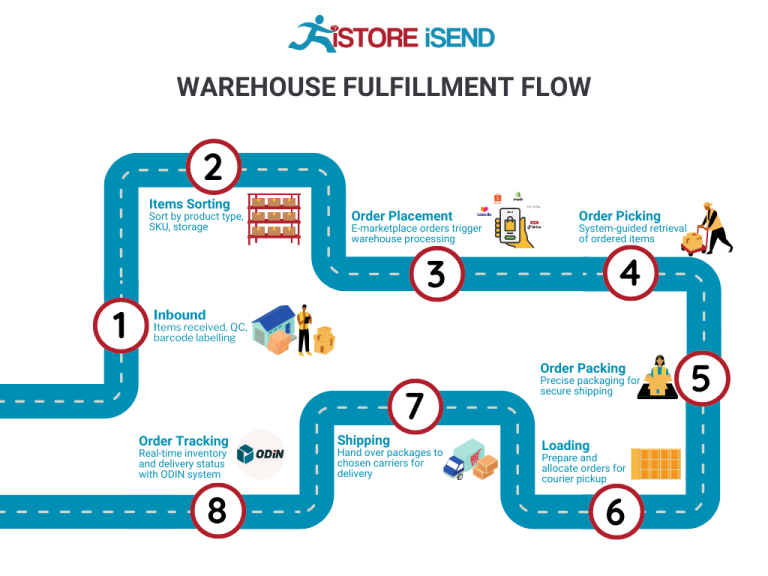
Implementing technology, such as pick-to-light systems or mobile scanning devices, can significantly improve picking efficiency and accuracy. Moreover, training staff on best practices and ergonomics can reduce errors and improve productivity. Efficient order picking ensures that customers receive the correct items on time, fostering loyalty and encouraging repeat business.
4. Order Packing
After items have been picked, they move on to the packing stage. This process involves carefully packaging products to ensure they arrive at the customer’s door in perfect condition. Proper packing is essential, especially for cosmetics, which can be fragile or sensitive to environmental conditions. Utilizing branded packaging not only protects items but also enhances the unboxing experience, creating a memorable moment for the customer.
Key considerations during packing include the use of void fill materials to prevent movement within the box, as well as proper labeling and documentation. Additionally, packing slips and return instructions should be included to streamline the post-purchase experience. A well-executed packing process not only reduces the likelihood of returns due to damage but also reinforces your brand’s commitment to quality.
5. Shipping & Delivery
The final step in the order fulfillment process is shipping and delivery. Once packages are packed, they are prepared for shipment, which involves selecting the appropriate carrier and shipping method based on factors like cost, speed, and customer preference. Offering multiple delivery options, such as standard, expedited, or same-day shipping, can greatly enhance customer satisfaction and meet diverse needs.
Key terms associated with this stage include tracking numbers, which provide customers with real-time updates on their order’s status. Efficient shipping processes, including timely dispatch and accurate tracking, are critical for maintaining customer trust and satisfaction. Collaborating with reliable shipping partners and utilizing technology for route optimization can further enhance delivery efficiency. Ultimately, a seamless shipping experience solidifies the customer’s perception of your brand and encourages repeat purchases.
By understanding and optimizing each step of the order fulfillment process—from receiving inventory to shipping and delivery—e-commerce businesses can significantly enhance their operational efficiency, meet customer expectations, and scale effectively in the competitive cosmetics industry.
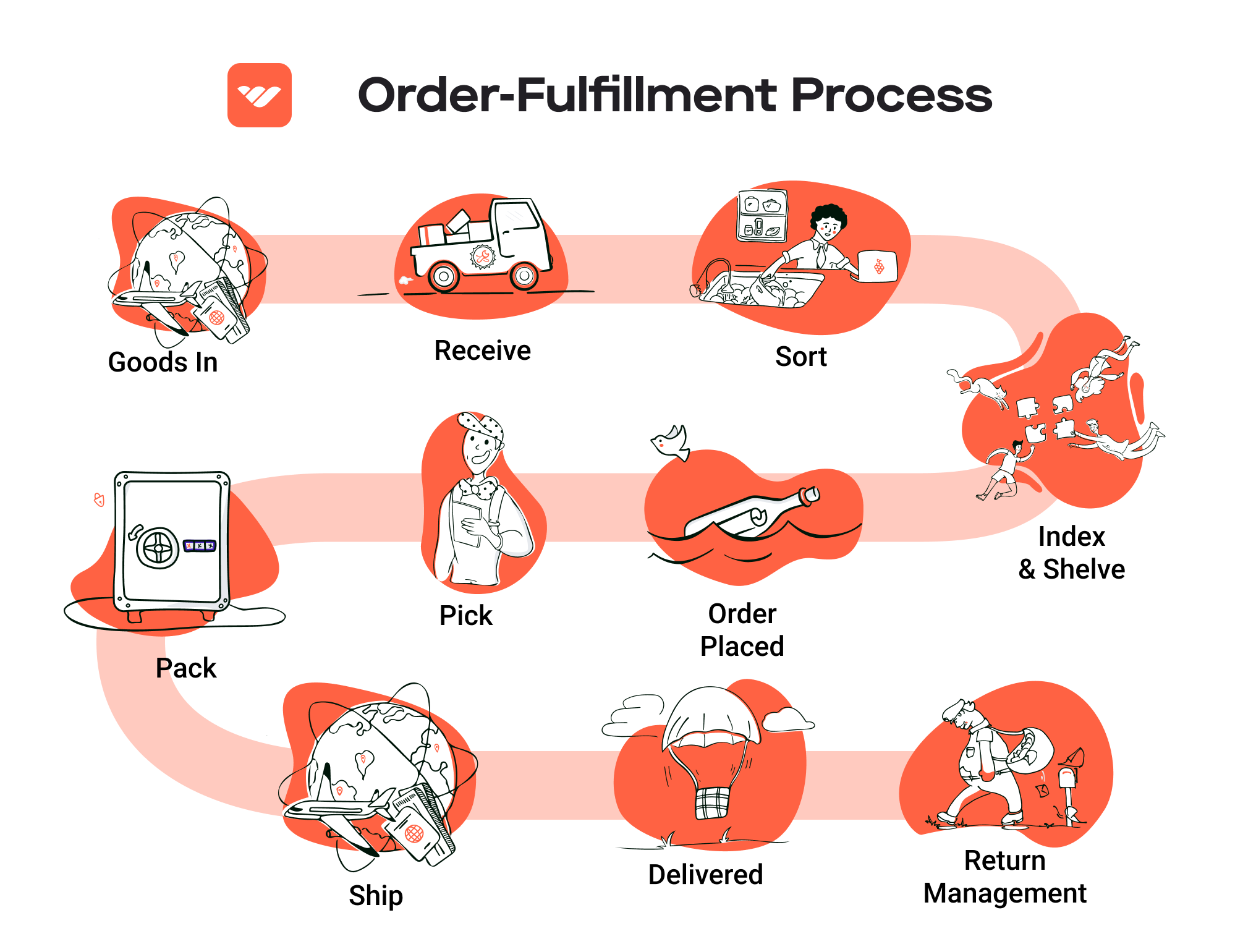
Comparing Fulfillment Models: In-House vs. 3PL vs. Dropshipping
Fulfillment Model Comparison Table
| Model | Who Handles Inventory | Best For (Business Stage) | Key Advantage | Key Disadvantage |
|---|---|---|---|---|
| In-House Fulfillment | The e-commerce business itself | Established brands with consistent demand | Complete control over inventory and fulfillment processes | High overhead costs and resource-intensive |
| Third-Party Logistics (3PL) | External logistics provider | Growing brands looking to scale | Access to expertise and technology without large investment | Less control over processes and potential communication issues |
| Dropshipping | Supplier or manufacturer | Start-ups or businesses testing markets | Low upfront investment and no inventory risk | Lower profit margins and potential quality control issues |
In-House Fulfillment
In-house fulfillment refers to a model where the e-commerce business manages its own inventory, storage, order processing, and shipping. This approach is typically adopted by established brands that have a steady stream of sales and can afford the necessary infrastructure. The primary advantage of in-house fulfillment is the complete control it offers over the entire logistics process. This control allows businesses to implement custom packing, ensure product quality, and provide a tailored customer experience. Additionally, businesses can quickly respond to customer inquiries and changes in demand. However, maintaining an in-house fulfillment operation can be costly and resource-intensive. It requires significant investment in warehousing, staff, and technology, which may not be feasible for smaller or emerging brands. Moreover, as sales grow, scaling operations can become complex and challenging.
Third-Party Logistics (3PL)
Third-party logistics (3PL) providers specialize in managing logistics and fulfillment services for businesses. Companies like PFS Commerce and J&J Global Fulfilment offer tailored solutions for beauty and cosmetics brands, ensuring that products are stored, picked, packed, and shipped efficiently. This model is particularly beneficial for growing brands that are looking to scale without the upfront costs associated with in-house fulfillment. By partnering with a 3PL, businesses gain access to advanced technology, expertise in logistics, and a scalable infrastructure that can adapt to seasonal fluctuations in demand. However, the trade-off is a potential loss of control over the fulfillment process. Communication issues can arise between the business and the 3PL, which can affect order accuracy and customer satisfaction. Additionally, businesses must ensure that their values align with those of the 3PL, particularly in areas like customer service and branding.
Dropshipping
Dropshipping is a fulfillment model where the retailer does not keep products in stock. Instead, when a customer places an order, the retailer purchases the item from a third-party supplier who then ships the product directly to the customer. This model is ideal for start-ups or businesses testing new markets, as it requires minimal upfront investment and eliminates inventory risk. Entrepreneurs can focus on marketing and customer acquisition without the burden of managing inventory or fulfillment logistics. However, dropshipping often comes with lower profit margins, as suppliers typically charge higher prices for their services. Additionally, businesses may face challenges related to quality control, as they have limited visibility over the product before it reaches the customer. Shipping times can also be longer, which may negatively impact the customer experience and brand reputation.
Conclusion
Choosing the right fulfillment model is critical for the success of any e-commerce business, especially in the competitive cosmetics industry. Each model has its unique advantages and disadvantages, making it essential for business owners to assess their specific needs, growth ambitions, and operational capabilities. In-house fulfillment offers control but requires significant resources, while 3PL solutions provide scalability and expertise but may involve a compromise on control. Dropshipping presents a low-risk entry point for new businesses but often at the cost of lower margins and quality assurance. Ultimately, the decision should align with the brand’s long-term strategy and customer experience goals.
A Deep Dive into Amazon FBA: Pros, Cons, and Who It’s For
Understanding Fulfillment by Amazon (FBA)
Fulfillment by Amazon (FBA) is a service offered by Amazon that allows sellers to store their products in Amazon’s fulfillment centers. Amazon then takes care of storage, packaging, shipping, and customer service on behalf of the sellers. This service is particularly appealing for e-commerce businesses, including those in the cosmetics and beauty industry, looking to streamline their logistics and expand their market reach.
When a customer places an order for a product fulfilled by FBA, Amazon picks, packs, and ships the product directly to the customer. Additionally, Amazon handles returns and customer inquiries, providing a seamless experience for both sellers and buyers. This is especially beneficial for cosmetics brands, where customer service and quick delivery are vital for maintaining brand loyalty and satisfaction.
How FBA Works
-
Setup: Sellers create an Amazon seller account and choose to enroll in the FBA program. They then prepare their products according to Amazon’s guidelines and ship them to Amazon’s fulfillment centers.
-
Storage: Once received, products are stored in Amazon’s warehouses. Sellers can monitor their inventory through Amazon’s platform, where real-time data is available.
-
Order Fulfillment: When a customer orders a product, Amazon handles the entire fulfillment process. This includes picking the product from the shelves, packing it in branded or unbranded packaging, and shipping it directly to the customer.
-
Customer Service: Amazon provides customer service for all FBA orders, including handling returns and inquiries, which saves sellers significant time and resources.
-
Payment: Sellers receive payments for their sales, minus Amazon’s fees, which vary depending on the size and weight of the product and the fulfillment services used.
Pros of FBA
-
Prime Eligibility: Products fulfilled by Amazon are automatically eligible for Amazon Prime, which can significantly increase sales. Prime members are more likely to purchase items that offer free two-day shipping, enhancing the attractiveness of FBA products.
-
Customer Trust: Leveraging Amazon’s established reputation helps build trust with potential customers. The assurance of fast shipping and reliable customer service can lead to higher conversion rates.
-
Multi-Channel Fulfillment: FBA isn’t limited to Amazon sales. Sellers can use FBA to fulfill orders from other sales channels, including their own websites and platforms like eBay. This flexibility can streamline operations and enhance inventory management.
-
Scalability: FBA allows businesses to scale quickly without needing to invest heavily in logistics infrastructure. As sales grow, sellers can send larger quantities of products to Amazon, simplifying the scaling process.
-
Focus on Growth: By outsourcing fulfillment to Amazon, sellers can focus more on marketing, product development, and customer engagement instead of day-to-day logistics.
Cons of FBA
-
High Fees: While FBA can save time, it comes at a cost. Sellers must pay various fees, including storage fees for inventory and fulfillment fees for each unit sold. These costs can add up, especially for low-margin products like cosmetics.
-
Strict Inventory Rules: Amazon has stringent guidelines regarding inventory management. Sellers must ensure their products meet Amazon’s quality standards and comply with regulations, which can be particularly challenging in the cosmetics industry, where product integrity is crucial.
-
Commingling Risks: FBA may commingle inventory with other sellers’ products. This means that if another seller’s item is damaged or defective, it could affect your inventory. This risk can be mitigated by using Amazon’s “Stickered Inventory” option, but it can complicate logistics.
-
Limited Control: When using FBA, sellers have less control over the fulfillment process, including packaging and branding. This can be a disadvantage for cosmetics brands that rely heavily on branding for customer loyalty.
-
Inventory Management Challenges: With FBA, sellers must forecast demand accurately to avoid overstocking or stockouts. Excess inventory can lead to increased storage fees, while stockouts can result in lost sales and negatively impact seller rankings.
Who is FBA Best For?
Fulfillment by Amazon is particularly beneficial for:
-
Startups and Small Businesses: Companies that lack the resources to manage their own logistics can leverage FBA to scale quickly without significant upfront investment in infrastructure.
-
Brands with High Demand: Businesses that experience seasonal spikes or high demand can benefit from FBA’s scalability and ability to handle increased order volumes without additional logistical burdens.
-
Sellers of Non-Perishable Products: While FBA is suitable for many product categories, it is especially ideal for non-perishable items, as cosmetics often have expiration dates. Sellers need to manage inventory closely to avoid waste.
-
Companies Focused on E-commerce Growth: Brands looking to enhance their online presence and reach a broader audience can take advantage of FBA’s Prime eligibility and customer trust to drive sales.
In summary, FBA offers a compelling solution for e-commerce businesses, particularly in the cosmetics sector, looking to simplify their logistics while enhancing customer satisfaction and trust. However, it’s essential to weigh the pros and cons to determine if it aligns with your specific business needs and goals.
Core Services Offered by Fulfillment Centers
Inventory Management & Warehousing
Inventory management and warehousing are foundational components of e-commerce fulfillment. Fulfillment centers utilize advanced inventory management systems to track stock levels, manage reorders, and provide real-time visibility into inventory status. This service includes climate-controlled storage for sensitive items, such as cosmetics, which can be affected by temperature and humidity.
Benefits:
1. Optimized Stock Levels: By maintaining accurate inventory counts, businesses can avoid stockouts and overstock situations. This ensures that products are available when customers want them, enhancing customer satisfaction.
2. Cost Efficiency: Proper inventory management reduces holding costs and minimizes waste, particularly for perishable or seasonal products. This translates into better margins for e-commerce businesses.
3. Data-Driven Decisions: With real-time reporting and analytics, businesses can make informed decisions about purchasing, marketing, and product development based on actual sales trends and inventory turnover rates.
Pick and Pack Services
Pick and pack services involve the process of selecting items from inventory (picking) and preparing them for shipment (packing). Fulfillment centers specialize in this service by employing efficient systems and trained staff to ensure accuracy and speed. For cosmetics and beauty products, this often includes careful handling to prevent damage to delicate items.
Benefits:
1. Speedy Fulfillment: Quick pick and pack operations lead to faster shipping times, which is crucial for meeting customer expectations in the fast-paced e-commerce environment.
2. Quality Control: Fulfillment centers implement rigorous quality checks during the pick and pack process to ensure that the right products are sent to the right customers, reducing the likelihood of returns and dissatisfaction.
3. Custom Packaging Options: Many fulfillment centers offer branded packaging solutions, enhancing the unboxing experience and strengthening brand identity. This is particularly beneficial in the beauty sector, where presentation can significantly influence customer perception.
Kitting and Assembly
Kitting and assembly refer to the process of grouping together various items into a single package or creating bundled offerings that may include multiple products. This service is particularly useful for cosmetics brands that want to offer gift sets, promotional bundles, or subscription boxes.
Benefits:
1. Enhanced Product Offerings: Kitting allows businesses to create attractive product bundles that can increase average order value and encourage upselling. For example, a skincare brand can bundle a cleanser, toner, and moisturizer as a complete skincare routine.
2. Efficient Order Processing: By assembling kits in advance, fulfillment centers can streamline the order processing time, allowing businesses to meet high demand during peak seasons or promotional periods.
3. Customizable Solutions: Businesses can easily adjust kits based on customer preferences or seasonal trends, enabling them to stay relevant and responsive to market changes.
Returns Management (Reverse Logistics)
Returns management, or reverse logistics, is the process of handling returned products efficiently and effectively. Fulfillment centers offer comprehensive returns management services, which include inspection, restocking, and processing refunds or exchanges. This is critical in the cosmetics industry, where customers may return products due to dissatisfaction, incorrect orders, or damaged items.
Benefits:
1. Customer Retention: An efficient returns process enhances customer satisfaction and loyalty. By making returns easy and hassle-free, businesses can maintain positive relationships with their customers, even after a return.
2. Cost Recovery: Properly managing returns can minimize losses. Fulfillment centers can assess returned items for resale, ensuring that any salvageable products are restocked and put back into circulation.
3. Data Insights: Returns management systems provide valuable data on return reasons and trends. This information can help businesses identify quality control issues, product performance problems, or areas for improvement in their offerings.
Conclusion
In summary, the core services offered by fulfillment centers—inventory management and warehousing, pick and pack services, kitting and assembly, and returns management—are integral to the success of e-commerce businesses, especially in the cosmetics sector. By leveraging these services, brands can streamline their operations, enhance customer experiences, and ultimately drive growth in a competitive marketplace. Investing in a reliable fulfillment partner can be a game-changer for e-commerce entrepreneurs looking to scale their logistics and sales efforts effectively.
How to Choose a Fulfillment Partner: A 6-Point Checklist
Location & Warehouse Network
Why It’s Important:
The geographical location of your fulfillment partner can significantly impact shipping times and costs. A partner with warehouses strategically located near your major customer bases can reduce transit times, improve delivery speed, and lower shipping expenses.
Questions to Ask:
1. Where are your warehouses located, and how many do you operate?
2. How do you determine the best warehouse for each order?
3. Do you have plans to expand your warehouse network in the near future?
Technology & Integrations
Why It’s Important:
In today’s digital landscape, seamless integration with your existing e-commerce platforms, inventory management systems, and customer relationship management tools is crucial. A fulfillment partner with robust technology can provide real-time tracking, order management, and inventory visibility, which are essential for maintaining customer satisfaction and operational efficiency.
Questions to Ask:
1. What technology platforms do you use for order processing and inventory management?
2. Can your system integrate with my current e-commerce platform (e.g., Shopify, WooCommerce)?
3. Do you provide real-time tracking for shipments and inventory levels?
Specializations (e.g., Cold Storage, Oversized Items)
Why It’s Important:
Different products have unique storage and handling requirements. If your cosmetics line includes items that require special handling—such as temperature-sensitive products or oversized packaging—partnering with a fulfillment provider that specializes in these areas is vital to ensure product integrity and compliance with regulations.
Questions to Ask:
1. What types of special handling or storage capabilities do you offer?
2. How do you manage products with expiration dates or specific storage conditions?
3. Can you accommodate oversized or fragile items, and what measures do you take to protect them?
Scalability & Capacity
Why It’s Important:
As your business grows, your fulfillment needs will evolve. A partner that can scale with your business will help you handle fluctuations in order volume, seasonal demand spikes, and new product launches without compromising service quality.
Questions to Ask:
1. How do you handle seasonal demand increases or unexpected order surges?
2. What is your current capacity for order fulfillment, and how flexible is it?
3. Are there any limitations to your scalability that I should be aware of?
Pricing and Contracts
Why It’s Important:
Understanding the pricing structure and contract terms of your fulfillment partner is essential to ensure that you can maintain profitability while providing excellent service. Hidden fees, long-term contracts, or inflexible pricing can quickly erode your margins.
Questions to Ask:
1. Can you provide a detailed breakdown of your pricing structure, including any potential hidden fees?
2. What are the terms of your contracts, and is there flexibility for renegotiation as my business changes?
3. Do you offer volume discounts or other incentives for long-term partnerships?
Customer Support & Reviews
Why It’s Important:
Reliable customer support is crucial when dealing with fulfillment issues, especially in the fast-paced e-commerce environment. A partner with strong customer service can help resolve problems quickly, ensuring minimal disruption to your operations. Additionally, reviews and testimonials from other clients can provide insight into the partner’s reliability and service quality.
Questions to Ask:
1. What customer support options do you provide (e.g., dedicated account manager, 24/7 support)?
2. Can you share references or case studies from other clients in the cosmetics industry?
3. How do you handle fulfillment issues or errors, and what is your process for resolution?
Conclusion
Choosing the right fulfillment partner is a critical decision that can significantly impact your e-commerce operations and customer satisfaction. By carefully considering these six key areas—location and warehouse network, technology and integrations, specializations, scalability, pricing, and customer support—you can make an informed choice that aligns with your business goals. Ensure that you conduct thorough research and ask the right questions to find a partner that will not only meet your current needs but also grow with your business as it scales.
Understanding Fulfillment Pricing: A Breakdown of Common Fees
Initial Setup Fees
Initial setup fees are the one-time costs associated with onboarding your business with a fulfillment provider. This fee can vary significantly depending on the complexity of your operations and the services offered by the provider. Typically, it covers the integration of your e-commerce platform with the fulfillment center, including software setup and customization, account management, and initial training for your team.
The calculation of initial setup fees often considers factors such as:
– Integration Complexity: More complex integrations (e.g., custom API connections) may incur higher fees.
– Volume of Products: If you have a large catalog, additional costs may arise from catalog setup and SKU management.
– Special Requirements: Unique storage needs (e.g., climate control for sensitive cosmetics) can increase setup costs.
It’s crucial to discuss all potential initial fees upfront to avoid surprises later on.
Receiving Fees
Receiving fees are charged when inventory is delivered to the fulfillment center. These fees cover the labor and resources needed to unload, inspect, and store incoming products. The cost structure can be based on several factors:
- Per Pallet or Box: Many providers charge a flat fee for each pallet or box received, which is straightforward and easy to calculate.
- Hourly Labor Costs: In some cases, providers may charge based on the time taken to process the incoming inventory, especially if it requires special handling or quality checks.
- Inspection Fees: If your products require inspection for quality assurance, additional charges may apply.
Understanding how receiving fees are structured can help you budget more accurately for incoming shipments.
Storage Fees (per pallet/bin)
Storage fees are recurring charges for keeping your products in the fulfillment center. These fees are typically calculated based on the space your inventory occupies, measured in pallets or bins. Factors influencing storage fees include:
- Type of Storage: Climate-controlled storage for sensitive products like cosmetics may incur higher fees than standard storage.
- Volume of Inventory: The more space your products take up, the higher the storage fees will be. Providers often use a tiered pricing structure where costs decrease as volume increases.
- Length of Storage: Some providers may charge differently based on how long items remain in storage, incentivizing quicker turnover.
Being aware of how storage fees are calculated can help you manage your inventory levels effectively, minimizing unnecessary costs.
Pick & Pack Fees (per item/order)
Pick and pack fees are charged for the labor involved in selecting items from storage and preparing them for shipment. These fees can vary widely based on the fulfillment center’s efficiency and your product type. Key considerations include:
- Per Item Fee: Many providers charge a set fee for each item picked and packed. This can be beneficial for businesses with a high volume of small orders.
- Per Order Fee: Some fulfillment centers charge a flat fee for each order fulfilled, regardless of the number of items. This model can be advantageous for businesses with fewer, larger orders.
- Complexity of Packing: If your products require special packing (e.g., gift wrapping, branded packaging), additional fees may apply.
Understanding the nuances of pick and pack pricing will help you select the right fulfillment partner based on your order volume and product types.
Shipping Fees
Shipping fees are the costs associated with delivering products to your customers. These fees can vary based on several factors:
- Shipping Method: Different carriers offer varying rates based on speed (standard vs. expedited) and service level (ground vs. air).
- Destination: Shipping costs will vary depending on the distance from the fulfillment center to the customer’s location.
- Package Size and Weight: Heavier or larger packages incur higher shipping costs. It’s essential to factor in these variables when pricing your products.
Many fulfillment providers offer discounted shipping rates through partnerships with major carriers, which can significantly reduce your overall logistics expenses.
Tips for Getting an Accurate Quote
- Provide Detailed Information: When requesting a quote, offer as much detail as possible about your product types, order volume, and specific fulfillment needs.
- Ask About Hidden Fees: Inquire about any additional fees that may not be immediately apparent, such as returns processing or special handling charges.
- Compare Multiple Providers: Gather quotes from several fulfillment centers to compare pricing structures and service offerings. Look beyond just costs; consider the quality of service and additional features.
- Negotiate Terms: Don’t hesitate to discuss and negotiate terms with potential providers. Many are willing to adjust their pricing based on your expected volume or long-term commitment.
- Request a Trial Period: If possible, request a trial period to assess the provider’s performance and ensure that their pricing aligns with your business needs before committing long-term.
By understanding these common fees and how they are calculated, you can make informed decisions that support your business’s growth while effectively managing fulfillment costs.
Frequently Asked Questions (FAQs) about Fulfillment
1. What is cosmetics fulfillment?
Cosmetics fulfillment involves the logistics of storing, packing, and shipping beauty products to customers. This process ensures that products are delivered in pristine condition, meeting customer expectations for quality and speed. Fulfillment services specifically designed for cosmetics also address unique challenges, such as product fragility and regulatory compliance related to ingredients and expiration dates.
2. How does cosmetics fulfillment differ from general fulfillment services?
While general fulfillment services handle a wide range of products, cosmetics fulfillment is tailored to meet the specific needs of beauty products. This includes special handling for fragile items, compliance with health regulations, and options for branded packaging and product personalization. The fulfillment process for cosmetics often requires climate-controlled storage and meticulous quality control to ensure product integrity.
3. What is a 3PL (Third-Party Logistics) provider?
A 3PL provider manages logistics and fulfillment services on behalf of a business. For cosmetics brands, a 3PL can offer specialized services such as inventory management, order processing, shipping, and returns handling. Utilizing a 3PL allows beauty brands to focus on marketing and product development while outsourcing the complexities of logistics.
4. How much do fulfillment services cost?
The cost of fulfillment services varies based on several factors, including order volume, storage needs, packaging requirements, and shipping methods. Typically, businesses can expect to pay for storage space, order processing fees, and shipping costs. Many fulfillment companies offer scalable pricing that adjusts with your business growth, making it essential to evaluate your specific needs when seeking quotes.
5. What should I look for in a cosmetics fulfillment partner?
When choosing a fulfillment partner, consider their experience with beauty products, the quality of their facilities, and their ability to provide specialized services like climate control and product personalization. Additionally, look for transparency in pricing, robust inventory management systems, and excellent customer service to ensure a smooth partnership.
6. How can fulfillment services improve customer satisfaction?
Fulfillment services enhance customer satisfaction by ensuring fast and accurate order processing, minimizing shipping errors, and providing high-quality packaging. A reliable fulfillment partner can also offer real-time tracking and efficient returns management, which contribute to a positive shopping experience and encourage repeat purchases.
7. What is the role of branded packaging in cosmetics fulfillment?
Branded packaging plays a crucial role in cosmetics fulfillment by creating a memorable unboxing experience that reflects the brand’s identity. High-quality, visually appealing packaging can enhance customer perception of the product, foster brand loyalty, and differentiate the brand in a competitive market.
8. How do fulfillment services handle returns for cosmetics products?
Fulfillment services typically have dedicated processes for handling returns, which may include inspecting returned products, restocking items, and managing inventory levels. For cosmetics, it’s essential to have a clear returns policy that addresses hygiene concerns and ensures that only undamaged products are restocked.
9. What technology is used in cosmetics fulfillment?
Fulfillment centers use various technologies to streamline operations, including inventory management software, order processing systems, and real-time reporting tools. Advanced systems can track inventory levels, monitor order status, and provide data analytics to help businesses make informed decisions about stock management and fulfillment strategies.
10. Can fulfillment services support seasonal demand fluctuations?
Yes, many fulfillment providers offer scalable solutions that can adapt to seasonal demand spikes, such as holiday shopping or promotional events. By partnering with a flexible fulfillment service, cosmetics brands can ensure they have the necessary resources to manage increased order volumes without compromising service quality.
Conclusion: Is Outsourcing Fulfillment the Right Move for Your Business?
Evaluating the Benefits of Outsourcing Fulfillment
Outsourcing fulfillment can be a transformative decision for your cosmetics e-commerce business. One of the most significant advantages is the time savings it offers. By partnering with a specialized fulfillment service, you can offload the complexities of inventory management, order processing, and shipping logistics. This allows you to focus on strategic activities, such as marketing and product development, that drive growth and enhance customer satisfaction.
Scalability is another key benefit. As your business experiences fluctuations in demand—whether due to seasonal trends or promotional campaigns—outsourced fulfillment partners provide the flexibility to scale operations without the need for significant upfront investment in warehousing or staffing. This adaptability is crucial in the fast-paced beauty industry, where consumer preferences can shift rapidly.
Moreover, leveraging the expertise of a fulfillment service can enhance the quality of your operations. These partners often come equipped with specialized knowledge in handling beauty products, ensuring that your items are stored, packed, and shipped in a manner that preserves their integrity. This expertise minimizes the risk of damage and maximizes customer satisfaction, leading to repeat purchases and brand loyalty.
However, the success of outsourcing fulfillment hinges on choosing the right partner. It’s essential to evaluate potential providers based on their capability to meet your specific needs, including handling unique packaging requirements, maintaining product quality, and providing excellent customer service.
Take Action
To determine if a fulfillment partner is the right next step for your business, conduct a thorough audit of your current shipping and logistics processes. Assess areas where time and resources are being spent inefficiently. By identifying gaps and evaluating potential fulfillment partners, you can strategically position your brand for growth and success in the competitive cosmetics market. Don’t hesitate—take this opportunity to optimize your operations and elevate your customer experience today.
Important Disclaimer
⚠️ Important Disclaimer
The information in this guide is for educational purposes. Fulfillment services, pricing, and platform features change frequently. Always conduct your own due diligence and consult with providers directly before making business decisions.
